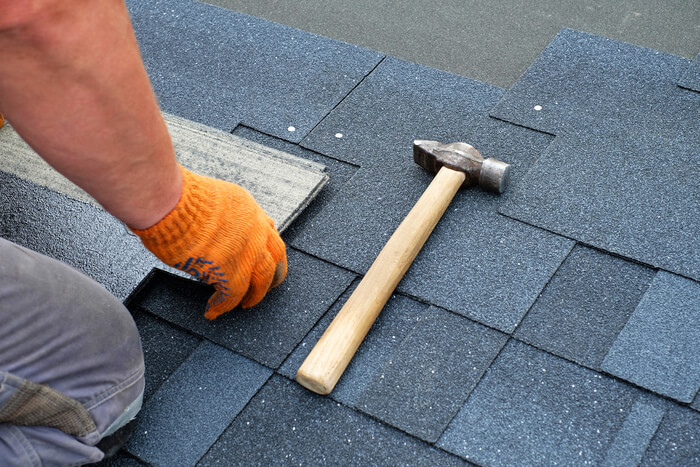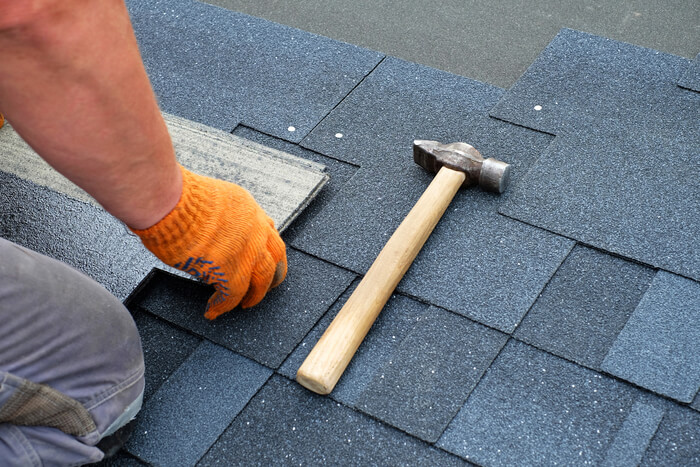Are you doing a roofing project?
Modernize can pair you with three to four pros in your area, so you can compare options and save time and money.
There are different kinds of surprises in life. Receiving an unexpected compliment? Good. Finding out your roof needs structural repairs? Not so good. The trouble with roofs is that problems aren’t always obvious from the ground. Sometimes a roofer or inspector has to get up on a roof — or even tear off the shingles and asphalt — before they can fully diagnose problems. And by that time, you may already be committed for several thousand dollars of work. If you don’t have a roofing emergency repair budget, this could be a major blow to your personal savings.
Like most home improvement projects, roof replacements and repairs go best when you prepare for the worst and expect the best — at least budget-wise. Here are a couple of common roofing “surprises,” and what they’ll cost you to fix.
Potential Roofing Emergency Repairs
Your roofer should send over an inspector before they make you a project estimate — and a good roofer will offer this service free of charge. But even a great inspector can’t predict every roofing issue. Once your roofing team pulls off the shingles or tiles under your roof, there’s a chance they might find damaged underlayment, like one of the following conditions.
Surprise 1: Rotten Decking
The number one roofing emergency repair issue uncovered during a tear-off is rotten or soft roof decking. Decking is the plywood sheathing that sits below your roof’s shingles and doesn’t always get replaced in every roofing project. In fact, if the decking seems to be in good shape, an honest roofer will usually leave it alone. However, if the roofer finds rotting or soft plywood when they tear off your home’s shingles, they’ll need to put in new sheathing first, before adding the roof on top of that.
Here are some signs that your deck is rotting:
- Spongy or discolored wood
- Flaky consistency or broken off pieces
- Large areas of gray mold or dark wood
- Plumbing leaks and broken drainage systems could also be a sign of rotten decking

Surprise 2: Inadequate Decking
If the roofer starts walking on your roof and finds that the decking is springy or bouncy, they’ll also recommend new sheathing. Modern decking is made from half-inch-thick plywood or OSB panels. But at one time, some local building departments didn’t require anything thicker than ⅜-inch. This thin plywood is now considered inadequate, so a roofer will usually replace it when they find it. Make sure your roofer is using the proper materials and installing your roof according to code. If they try to cut corners, you’ll probably end up expanding your roofing emergency repair budget.
Though every state has slightly different roofing regulations, let’s look at California’s building code for an idea of proper roofing standards.
- Wood shingles and shakes must be treated with a fire retardant property.
- Gutters must be made of noncombustible material.
- Asphalt shingles must be textured for wind resistance.
- Concrete and clay tiles can only be laid over solid sheathing or sheathing boards.
- There are specific standards for every different type of building material, from copper to steel to different types of wood and stone. You’ll need to make sure that your roofer is using up-to-code materials.
- Roof material, exposure level, slope, and temperate climate are all factors with which your roof must be compliant to your state laws.
How Much Should I Expect to Spend to Replace Roof Decking?
Your roofer should charge you only for the labor and materials used for a roofing project. A standard piece of plywood roofing sheathing measures 4 x 8 feet, and anywhere from ¼ of an inch to ⅝-inch thick. The thicker the plywood your roofer uses, the more expensive the job will be. Your price could vary depending on how much the roofing company charges for labor, but generally, you can expect to spend between $70 to $100 for each sheet of plywood.
A 4 x 8 sheet of plywood covers about 32 square feet of roof area — and the average roof measures about 3,000 square feet. That means new decking could potentially add several thousand dollars to your roofing project.
Three Problems Commonly Uncovered by Roofing Inspectors
Occasionally, a roofing inspector will stumble across a bigger issue, one that warrants a major repair. It can be difficult to notice these kinds of roofing emergency repairs from the ground — and unless your roof leaks or you find shingles blown off in your yard, you might not realize there was anything going on with your home’s roof at all. Here are the most common larger issues found during roofing inspections.
Problem 1: Storm Damage
While you’ll probably notice if a branch or other debris piles onto your roof, hail damage can be much more insidious. Shingles and panels are almost always replaced entirely rather than patched up, making the cost of hail-damaged roof replacement higher.
Depending on the area in which you live, materials used, and contractor, you can expect to pay between $400 and $800 per every 100 square feet for roof repair and replacement. If you end up needing a full roof replacement, it could cost you between $7,500 and $15,000 for the average home size and roofing style.
Your roof shingles are probably rated to protect your roof from the worst hail damage — but small hailstones can still cause problems. Tiny holes in your roof can expose your underlayment to rain and other moisture, which will cause mold, rot, and leaks. An inspector can spot hail damage right away, so you can get your insurance on the case to repair or replace your roof. A claim that’s filed too long after the initial weather event may not be covered by insurance.
Problem 2: Drainage Issues
Another issue you might not be able to detect from below is whether your roof’s drainage system is working properly. A blocked drainage system can result in ponding water on your roof’s surface, which an inspector can see when they get up on your roof. That’s a good thing, since pooling or ponding water can result in eventual leaks or even roof collapse.
Approximately 85% of home repair expenses in the U.S. are due to water damage. Here are some ways you can spot drainage issues in your home:
- Water is flowing over gutters instead of through them due to debris buildup.
- Vertical dirt smears on gutter exteriors or muddy siding, as this indicates excess moisture.
- Water buildup near the foundation of your house, meaning your gutters are depositing water too close to your home.
- Standing water in your yard due to improper drainage.
- Warped or bowing parts of your drainage system might mean that your drainage system isn’t working properly.
Problem 3: Cost vs. Scope of Damage
The cost to fix these issues depends largely on the scope of the damage.
Find the Right Contractor for Your Roofing Project
Whether you’re ready to begin your project now or need some expert advice, our network of contractors are here to help. With a few simple questions, we’ll find the best local professionals for you
However, an average roofing repair costs between $300 to $1,000 — a lot less than a total replacement. When it comes to extending your roof’s lifespan, seeking out and fixing problems early is the best way to go.
Some roofers will suggest that you get a full replacement rather than fix the damaged spot to drive up the price of the job. While an honest roofer won’t pad the project, it’s a good idea to get multiple estimates before going forward. With two or three opinions, you’ll have a better estimate of exactly how much your roofing repair should cost.
Additionally, don’t be afraid to ask your roof contractor for references. That way you can talk to past clients and gauge how good or bad their experience was.
How to Afford Roofing Emergency Repairs
Do you have a roofing emergency and no roofing emergency budget? You still have options to finance your project.
1. 0% APR credit card
Simply put, a 0% APR credit card is a regular credit card with a 0% introductory rate. If you’re able to repay your credit card charges within the introductory time period, you could avoid paying interest on your roofing expenses altogether. Most 0% APR periods fall within the range of 12 to 18 months, though your specific terms and conditions will be decided by your chosen lender. Keep in mind that the interest rate will dramatically increase after the introductory period, so if you can’t pay off your expenses before that time this might not be the right option for you.
With some 0% APR cards, you’ll also have the option to get cashback on purchases. For example, The Chase Freedom Card, which is 0% APR, offers 5% cashback when you spend $1,500 in a quarter and 1% back on all purchases. This equates to more money you can put into your roofing emergency budget.
2. Home Repair Grants
The Federal Government offers home repair rebates and grants for specific circumstances. If you’re eligible, you could have your roofing emergency budget completely paid for. Most of the federal home repair grants are need-based financial aid for low-income areas and families and intended to improve communities in need of financial aid.
Here are two home repair grants worth looking into:
Single-Family Housing Repair Grant
- Offered by the U.S. Department of Agriculture
- Applies to families who own their house and have an income below 50% the area median income
- Maximum amount available for a grant is $7,500
- Find out more information here
Community Development Block Program
- Offered by the U.S. Department of Housing and Urban Development
- Applies to low and moderate-income individuals for the purpose of improving vulnerable communities
- Find out if you’re eligible here
3. Personal Loan
Your ability to obtain a personal loan is contingent on a number of factors, including your credit score, needed loan amount and desired repayment timeline. If you’re granted a personal loan, you’ll have access to cash that you can use for any purpose — giving flexibility when financing a roofing project and also paying day-to-day bills.
Be sure to check the APR range on different personal loans, as the interest you’re paying will make a big difference in your eventual total loan cost. APR can be as low as 5.99% and as high as 35.89% depending on your financial history and lender — so make sure you’re getting the best deal possible when it comes to APR by comparing rates online.
Make sure to ask your lender for all fees and monthly payments before taking out a personal loan to be sure you can cover the expense and still afford necessary items.
4. Home Equity Line of Credit
A home equity line of credit (HELOC) requires a certain percentage of built up home equity to use. HELOCs are secured by your home, making them risky in the fact that if you don’t make payments on time you could lose your house. Once you have secured a line of credit, you’ll get a card from your bank that works similar to a credit card with a revolving amount of credit. You’re borrowing against what you’ve already paid into your property when you use a HELOC.
Depending on your lender, you can opt for either a fixed or variable interest rate for a HELOC. With a fixed rate, your monthly payments won’t be subject to change. With a variable rate, payments will change with your balance and fluctuating interest rates.
Lenders typically look at the following to determine if you’re eligible for a HELOC:
- Credit score and history
- Employment history
- Monthly income
- Outstanding debts
- Current mortgage payments
Avoid Problems by Having Your Roofing Inspected Regularly
The National Roofing Contractors Association recommends that you have your roof inspected twice a year — once in the fall, after hot weather has subsided, and once in the spring, after the danger of ice and snow is behind you. You should also have your roof inspected after a big storm, hurricane, or another potentially damaging weather event to avoid a roofing emergency repair.
The inspector will get up on top of your roof, and from that vantage point, they’ll be better able to see any issues that need correcting. An inspector can point out the smallest issues to ones that may have grave consequences — everything from cracked shingles to mold. A roofing repair is much more cost-effective than a complete re-roof, so anything you can do to locate issues early will save you money in the long run.
Find the Right Contractor for Your Roofing Project
Whether you’re ready to begin your project now or need some expert advice, our network of contractors are here to help. With a few simple questions, we’ll find the best local professionals for you
Reviews from Real Homeowners
Welcome to Homeowner Resources! We are the Modernize blog. Modernize pairs more than 3 million homeowners a year with pre-vetted contractors in their area. This blog started because we believe homeowners should know everything about their homes, from how their HVAC works to which front door colors they might love. On Homeowner Resources, you can find information on every part of your home, right down to how you can negotiate with contractors to get the best price. Here's more about the blog.
Need a contractor? Learn more about how Modernize finds the right pro for you.








